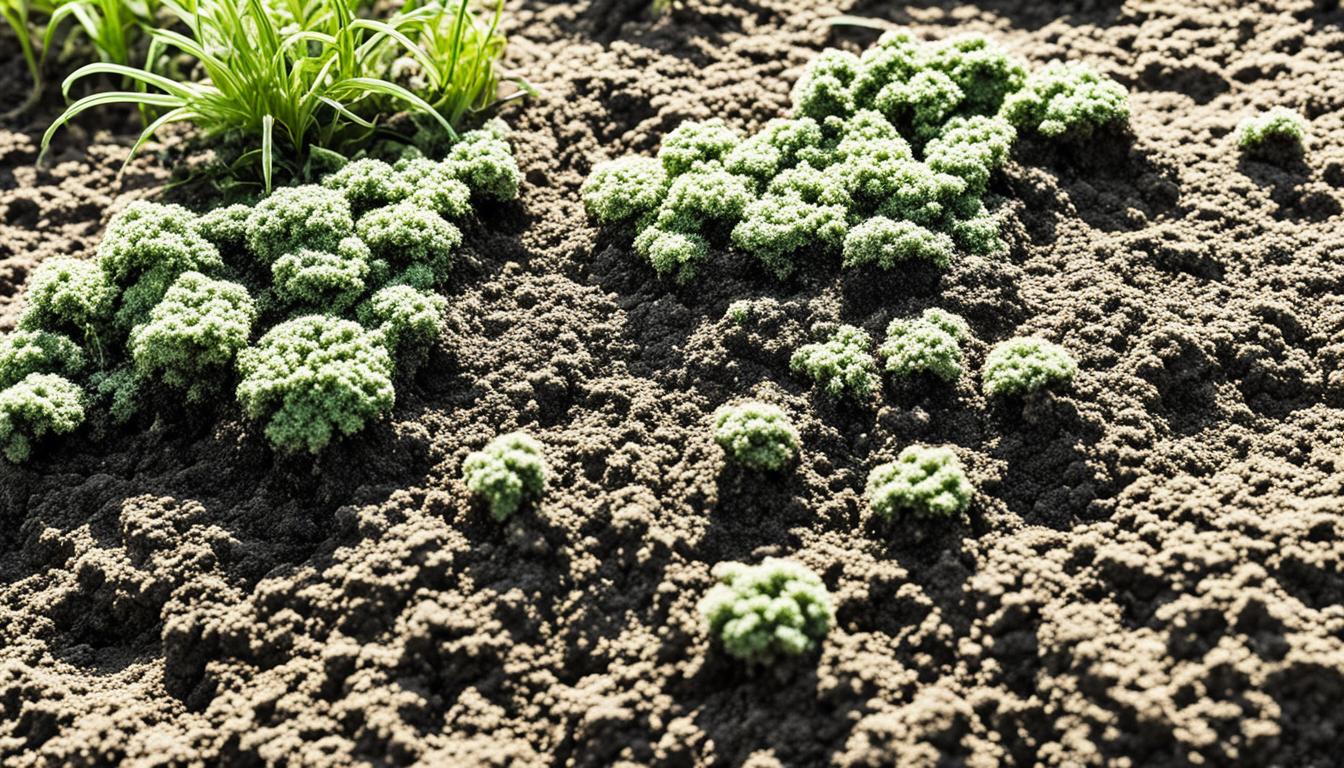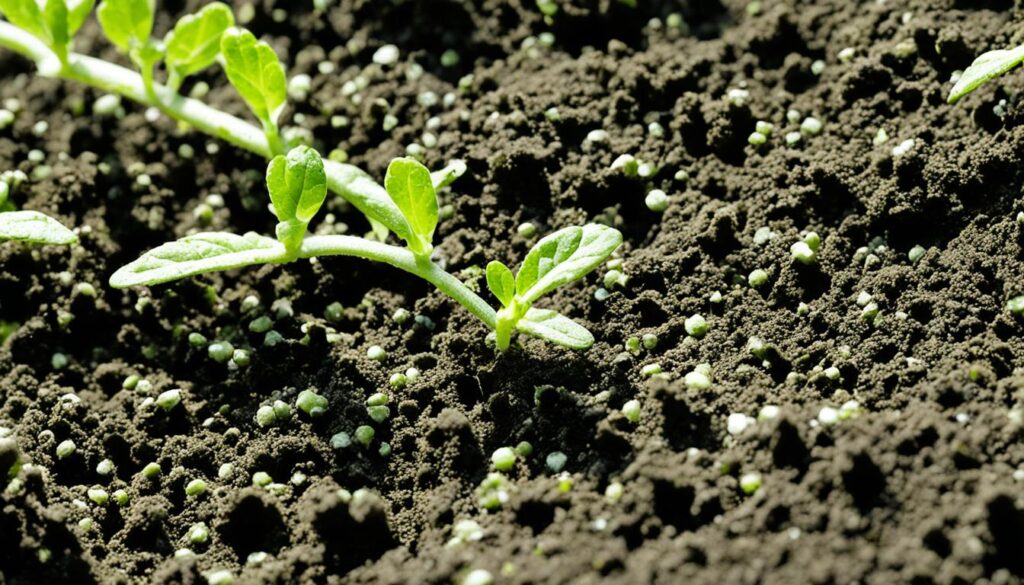
Eradicate Mould on Soil: Effective Solutions
Welcome to our comprehensive guide on how to eradicate mould growth on soil. Mould growing on soil can have significant consequences for soil health and plant growth. It is crucial to find effective solutions to fix mould on soil and prevent it from reappearing. In this article, we will explore the causes of mould growth on soil, assess soil mould levels, discuss proven remediation techniques, provide tips for preventing its reoccurrence, restore soil health after an infestation, and highlight the importance of professional mould remediation services.
Before we delve into these topics, let us understand the detrimental effects of mould on soil health. Mould can negatively impact the structure and fertility of soil, inhibiting plant growth and reducing crop yields. Additionally, certain mould species can release toxic substances that pose a threat to human and animal health. Therefore, taking action to eradicate mould on soil is of utmost importance.
Key Takeaways:
- Mould growing on soil can have detrimental effects on soil health and plant growth.
- Fixing mould on soil requires understanding the causes and conditions conducive to mould growth.
- Assessing soil mould levels is essential before implementing any remediation techniques.
- There are effective techniques for removing mould from soil, including physical removal, solarization, and organic fungicides.
- Preventing mould from reappearing on soil involves proper watering techniques, improving soil drainage, and using preventive fungicides.
Now, let’s dive deeper into each section to explore these topics in detail and provide you with practical solutions to eradicate mould growth on soil.
Understanding Mould Growth on Soil
When it comes to maintaining a healthy garden, dealing with the presence of mould growing on soil is crucial. Mould growth not only affects the aesthetic appeal of the garden but also poses significant risks to soil health and plant vitality. Understanding the causes, types, and prevention strategies for soil mould is essential in maintaining a thriving garden ecosystem.
Causes and Conditions for Mould Growth on Soil
Several factors contribute to the growth of mould on soil, including:
- Excessive moisture: When the soil retains too much moisture, it creates a conducive environment for mould spores to germinate and proliferate.
- Poor drainage: Inadequate drainage prevents excess water from escaping the soil, leading to moisture accumulation and promoting mould growth.
- Organic matter decomposition: Decomposing organic matter provides nourishment to mould spores, enabling them to thrive in the soil.
Types of Mould That Affect Soil
There are various types of mould commonly found growing on soil. These include:
- Aspergillus: This type of mould is characterized by its powdery texture and tends to grow in areas with high humidity.
- Penicillium: Penicillium mould appears green or blue in color and is typically found on decaying organic matter in the soil.
- Fusarium: Fusarium mould is often associated with plant diseases and can cause wilting and decay in affected plants.
- Trichoderma: Trichoderma mould, also known as green mould, is commonly found in compost and potting mixes. It can inhibit the growth of other harmful fungi.
It’s important to identify the specific type of mould affecting your soil to implement effective treatment and prevention strategies. Now that we have an understanding of the causes and types of soil mould, we can move on to assessing soil mould levels and determining the appropriate remediation techniques in the upcoming sections.
Assessing Soil Mould Levels
The first step in effectively remediating mould growing on soil is to assess the mould levels present. By determining the extent and type of mould infestation, you can implement targeted solutions to fix the issue and ensure a healthy soil environment.
There are two primary methods for assessing soil mould levels: professional mould assessments and DIY testing kits. Professional mould assessments are conducted by experienced technicians who collect samples from different areas of the soil and analyze them in a laboratory. Their expertise ensures accurate identification of the specific mould species present and provides valuable insights into the severity of the infestation.
If you prefer a more hands-on approach, you can opt for DIY testing kits readily available in the market. These kits typically include sampling tools, testing containers, and detailed instructions on how to collect and analyze soil samples yourself. While they may not provide the same level of accuracy as professional assessments, they can still provide you with a general idea of the mould levels in your soil.
Identifying the specific mould species is crucial for effective mould remediation. Some species may require different treatment approaches than others, so knowing the exact type of mould you’re dealing with allows you to tailor your remediation efforts accordingly.

Effective Soil Mould Remediation Techniques
If you’re dealing with mould growing on soil, it’s crucial to take immediate action to prevent further damage to your plants and soil health. Fortunately, there are proven techniques for removing mould from soil that can help you reclaim a healthy growing environment. In this section, we’ll outline three effective soil mould remediation techniques: physical removal, solarization, and organic fungicides.
1. Physical Removal
Mould can sometimes be visible on the surface of the soil or around the base of plants. To remove mould physically:
- Carefully remove the affected soil using a spade or hand trowel, ensuring not to disturb the plant roots.
- Dispose of the mouldy soil in a sealed bag to prevent further contamination.
- Replace the removed soil with fresh, healthy soil.
2. Solarization
Solarization is an effective technique for eliminating mould spores and other pathogens from the soil. Here’s how you can solarize your soil:
- Choose a sunny, hot day during the summer.
- Remove any plant debris and weeds from the soil surface.
- Moisten the soil to a depth of 6-8 inches.
- Cover the moist soil with a clear plastic tarp, securely anchoring the edges to the ground.
- Leave the tarp in place for 4-6 weeks to allow the heat to kill the mould and other pathogens.
- Remove the tarp and let the soil cool before replanting.
3. Organic Fungicides
Using organic fungicides can help control and eliminate mould from soil. Look for fungicides that are specifically formulated for soil applications and contain natural ingredients such as neem oil, garlic extract, or copper fungicides. Follow the product instructions carefully to ensure safe and effective application.
Remember to always wear protective gloves and clothing when handling fungicides, and keep them out of reach of children and pets.
By employing these effective soil mould remediation techniques, you can eliminate mould growth and restore a healthy environment for your plants. Take proactive steps to prevent mould from reappearing in the future by improving soil drainage, promoting proper airflow, and practicing good watering techniques.
For additional guidance and professional assistance, consider contacting a reputable mould remediation service such as Fix Mold Miami at 305-465-6653. They have the expertise and tools to assess and remediate soil mould effectively.
Continue reading to learn more about preventing mould from reappearing on soil and restoring soil health after a mould infestation.
Preventing Mould from Reappearing on Soil
Once you have successfully removed mould from your soil, it is essential to take preventive measures to ensure it does not reappear. By following these soil maintenance tips and implementing effective mould control strategies, you can safeguard your soil and promote healthy plant growth.
Proper Watering Techniques
Overwatering can create a conducive environment for mould growth on soil. To prevent this, water your plants at the base, near the roots, rather than using overhead sprinklers. This method helps keep the foliage dry and minimizes moisture accumulation on the soil surface.
Improving Soil Drainage
Excess moisture is a primary catalyst for mould growth. Improve soil drainage by incorporating organic matter, such as compost or well-rotted manure, into the soil. This will enhance its structure, allowing better water percolation and reducing the risk of waterlogged conditions that favor mould development.
Using Preventive Fungicides
In some cases, applying preventive fungicides can help control mould growth on soil. These products contain active ingredients that inhibit mould development and protect your plants from potential infestations. However, it is important to carefully follow the instructions and dosage recommendations when using fungicides.
“Proper watering techniques, improving soil drainage, and using preventive fungicides are powerful tools to prevent mould from reappearing on soil.”
By implementing these soil maintenance tips and mould control strategies, you can create an unfavorable environment for mould growth and maintain good soil health. Regularly monitor your plants and soil for any signs of mould reinfestation, and take immediate action if necessary.
To further enhance your knowledge about mould growing on soil and its remediation, continue reading through the next section, where we discuss effective techniques for restoring soil health after a mould infestation.

Restoring Soil Health After Mould Infestation
After successfully removing mould from your soil, it’s vital to restore its health to ensure optimal plant growth and prevent future infestations. Restoring soil health requires a combination of techniques that address the root causes of mould growth and promote a balanced and thriving ecosystem.
Promoting Beneficial Soil Microorganisms
One key step in restoring soil health is to promote the growth of beneficial soil microorganisms that contribute to the natural balance and fertility of the soil. These microorganisms help break down organic matter, improve soil structure, and enhance nutrient availability for plants.
To encourage the growth of beneficial microorganisms, consider incorporating compost into the soil. Compost is rich in organic matter and provides an excellent source of nutrients for microorganisms. Additionally, using compost tea, which is a liquid made from steeping compost in water, can help introduce beneficial microorganisms into the soil.
Improving Soil Structure
Mould growth can impact soil structure, leading to compaction and poor drainage. To improve soil structure, incorporate organic matter such as compost, leaf mold, or well-rotted manure into the soil. Organic matter helps create pore spaces in the soil, allowing for better air and water movement.
Regularly aerating the soil can also help improve its structure. This can be done with a garden fork or with specialized aerating equipment to alleviate compaction and enhance soil porosity.
Regular Soil Testing and Nutrient Supplementation
Regular soil testing is essential to determine the nutrient levels and pH of the soil. Testing allows you to identify any deficiencies or imbalances that may hinder plant growth. Based on the soil test results, you can then supplement the soil with the necessary nutrients to support healthy plant growth and prevent mould infestations.
Note: It’s crucial to follow the recommended application rates for any fertilizers or soil amendments to avoid over-application, which can lead to nutrient imbalances and further complicate soil health.
Summary Table: Steps to Restore Soil Health After Mould Infestation
| Steps | Description |
|---|---|
| Promote Beneficial Soil Microorganisms | Add compost and compost tea to introduce beneficial microorganisms into the soil. |
| Improve Soil Structure | Incorporate organic matter and regularly aerate the soil to enhance soil structure and drainage. |
| Regular Soil Testing | Conduct soil tests to assess nutrient levels and pH, and supplement the soil as needed. |
By following these steps and incorporating them into your soil maintenance routine, you can restore soil health after a mould infestation and create an environment that fosters healthy plant growth and prevents future mould problems.
Professional Mould Remediation Services
When it comes to dealing with mould growing on soil, sometimes the best course of action is to enlist the help of professional mould remediation services. These experts have the knowledge, expertise, and tools to effectively address the issue, ensuring a thorough and long-lasting solution.
Professional mould remediation services bring several benefits to the table. Firstly, they have extensive experience in dealing with mould infestations, enabling them to quickly and accurately assess the severity of the problem. With their expertise, they can identify the underlying causes and recommend the most suitable remedial measures.
Moreover, professional mould remediation services employ advanced tools and equipment to carry out effective treatments. They utilize specialized techniques such as HEPA vacuuming, dry ice blasting, and antimicrobial treatments to eradicate mould and prevent its regrowth. These methods are not only efficient but also safe, ensuring the health and well-being of both humans and plants.
Assessment and prevention services are also integral to professional mould remediation. These services involve thorough inspections to identify potential areas of concern and implement proactive measures to prevent mould growth in the future. By addressing the underlying causes, professional remediation services can help ensure a mould-free environment for your soil and plants.
One reputable provider of mould remediation services is Fix Mold Miami, based in Miami, Florida. With their years of experience and commitment to excellence, they have established themselves as a trusted resource in the field. By enlisting their services, you can have peace of mind knowing that your soil will be in expert hands.
To summarize, professional mould remediation services offer a comprehensive solution to fix mould on soil. Their expertise, tools, and assessment services ensure effective mould removal and prevention. By choosing a reputable service provider like Fix Mold Miami, you can restore the health and vitality of your soil, providing an optimal environment for your plants to thrive.
Conclusion
In conclusion, it is crucial to take effective action to eradicate mould on soil. As discussed in this article, mould growth on soil can have a detrimental impact on soil health and plant growth. By understanding the causes and conditions that contribute to mould growth and assessing soil mould levels, you can identify appropriate remediation techniques.
Implementing proven techniques such as physical removal, solarization, and organic fungicides can effectively remove mould from soil. Furthermore, preventing mould from reappearing on soil requires proper watering techniques, improving soil drainage, and using preventive fungicides. Maintaining good soil health through regular soil testing and nutrient supplementation is also essential.
If you are facing a severe mould infestation on your soil, it is recommended to seek professional help. Fix Mold Miami, a reputable mould remediation service provider, offers expert assessment and remediation services. Contact them at 305-465-6653 to address your soil mould concerns and restore the health of your soil.




